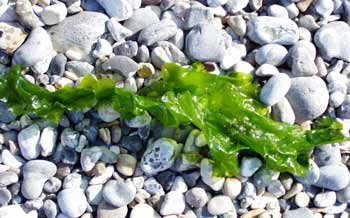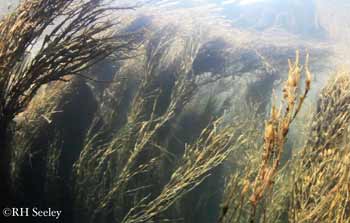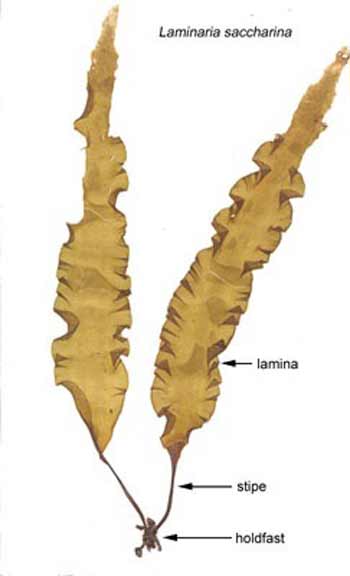Maine Seaweeds Defined

Green sea lettuce as found on the beach.
World demand has been rapidly increasing for rockweed and various seaweed species native to the coast of Maine. There has been some confusion about the differences between these species as expressed in news reports and within the industry that harvests them. This confusion has been both not surprising and problematic.
It’s not surprising because until about 15 years ago the harvest of seaweed was well below the radar. The Maine Department of Marine Resources has no management plan in effect and has no resident expert seaweed scientist at what may be a critical time for an important resource. The confusion and lack of good science on this resource is problematic because world demand results in international corporations attempting to lock in rights of access for themselves over local harvesters.

Rockweed at high tide in Lubec, Maine.
This combination of industrial extraction pressure, lack of understanding of the ecological impacts of harvesting and an appropriate metric for “sustainable” harvests, and a legal dispute over ownership has prompted this explanation of the intertidal seaweeds under discussion in Maine. To start with, seaweeds are divided by scientists into three groups: green, red and brown seaweeds.
Kelp and rockweed are both brown seaweeds and are continually confused in the media and on product labels. True kelps (for example, Laminaria saccharina) are edible, and are being farmed successfully in Maine and elsewhere as a result of a high growth rate. Rockweed (Ascophyllum nodosum) while often mistakenly referred to as “kelp,” or just “seaweed” on garden products, is not edible, and grows very slowly.

Eatable kelp. The long leaves are upright at high tide and draped over rocks with other seaweeds at low tide.
Seaweeds can also be distinguished by their use for human food or for fertilizer. Edible seaweeds include dulse, nori, sea lettuce, digitata. The seaweed primarily used for fertilizer worldwide is rockweed. Another way to distinguish seaweeds is by lifespan and ecology. Sea vegetables tend to be fast-growing or ephemeral, like sea lettuce. Rockweed is a perennial, slow growing, habitat-forming seaweed. Rockweed and kelps are known as “ecosystem engineers”, creating marine habitat structure, but whereas kelp grows quickly (3 feet annually), rockweed grows much more slowly (inches per year). Rockweed plants, like oak trees, are long lived and their upper branches spread out creating a complex habitat that supports fish, numerous small invertebrates, and even crawling lobsters at high tide, while shading and protecting the intertidal community from heat at low tide. Rockweed persists in part because it contains the same class of defensive plant chemicals as oak leaves, which protect oak leaves from most insects and make rockweed inedible to most humans and other consumers.
